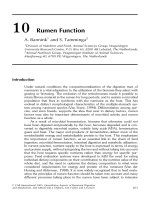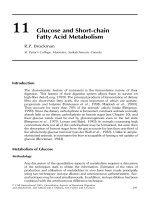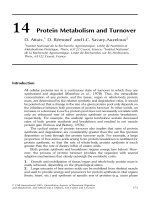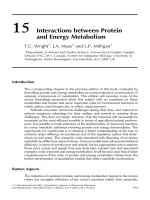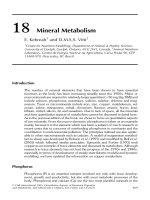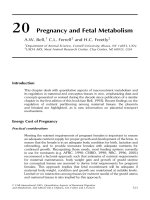Tài liệu Reserve Bank of India: Functions and Working doc
Bạn đang xem bản rút gọn của tài liệu. Xem và tải ngay bản đầy đủ của tài liệu tại đây (9.66 MB, 122 trang )
Reserve Bank of India:
Functions and Working
ž¸¸£·¸ú¡¸ ¹£ö¸¨¸Ä ¤¸ÿˆ
RESERVE BANK OF INDIA
www.rbi.org.in
2
3
The Reserve Bank of India, the nation’s central bank, began operations on April
01, 1935. It was established with the objective of ensuring monetary stability
and operating the currency and credit system of the country to its advantage.
Its functions comprise monetary management, foreign exchange and reserves
management, government debt management, financial regulation and
supervision, apart from currency management and acting as banker to the
banks and to the Government. In addition, from the beginning, the Reserve
Bank has played an active developmental role, particularly for the agriculture
and rural sectors. Over the years, these functions have evolved in tandem with
national and global developments
This book aims to demystify the central bank by providing a simple account of
the Reserve Bank’s operations and the multidisciplinary nature of its functions.
The Bank today focuses, among other things, on maintaining price and
financial stability; ensuring credit flow to productive sectors of the economy;
managing supply of good currency notes within the country; and supervising
and taking a lead in development of financial markets and institutions. The
book serves to highlight how the Reserve Bank’s decisions touch the daily lives
of all Indians and help chart the country’s economic and financial course.
We hope that readers would find the book , authored by the staff of the Bank,
useful in getting a better appreciation of the policies and concerns of the
Reserve Bank.
Foreword
Dr. J. Sadakkadulla
Principal
Reserve Bank Sta College
Chennai
4
5
Contents
S. No. Chapters Page No.
1 Overview 7
2 Organisation 12
3 Monetary Management 21
4 Issuer of Currency 27
5 Banker and Debt Manager to Government 32
6 Banker to Banks 35
7 Financial Regulation and Supervision 38
8 Foreign Exchange Reserves Management 52
9 Foreign Exchange Management 55
10 Market Operations 60
11 Payment and Settlement Systems 63
12 Developmental Role 67
13 Research and Data Dissemination 76
14 How Departments Work 79
15 Chronology of Important Events in the History of the Bank 107
Annex - 1 Publications by the Reserve Bank 112
Annex – 2 List of Abbreviations 114
6
Index on Boxes
S. No. Name of the Box Item Page No.
1 Origins of the Reserve Bank of India 8
2 Functions of the Reserve Bank 8
3 Central Office Departments 15
4 Monetary Policy Transmission 24
5 Currency Unit and Denomination 28
6 Banker to Banks 36
7 Prudential Norms 41
8 Investment of Reserves 53
9 Foreign Exchange Reserves Management: The RBI’s Approach 54
10 Payment and Settlement System: Evolution and Initiatives 64
11 Institutions to meet Needs of the Evolving Economy 73
12 Improving Banking Services in Comparatively Backward States 74
7
The origins of the Reserve Bank of India can be traced to 1926, when the
Royal Commission on Indian Currency and Finance – also known as the
Hilton-Young Commission – recommended the creation of a central bank for
India to separate the control of currency and credit from the Government and
to augment banking facilities throughout the country. The Reserve Bank of
India Act of 1934 established the Reserve Bank and set in motion a series of
actions culminating in the start of operations in 1935. Since then, the Reserve
Bank’s role and functions have undergone numerous changes, as the nature of
the Indian economy and financial sector changed.
Overview
1
8
Starting as a private shareholders’ bank, the Reserve Bank was nationalised
in 1949. It then assumed the responsibility to meet the aspirations of a newly
independent country and its people. The Reserve Bank’s nationalisation aimed
at achieving coordination between the policies of the government and those
of the central bank.
1926: The Royal Commission on Indian Currency and Finance recommended
creation of a central bank for India.
1927: A bill to give effect to the above recommendation was introduced in
the Legislative Assembly, but was later withdrawn due to lack of agreement
among various sections of people.
1933: The White Paper on Indian Constitutional Reforms recommended the
creation of a Reserve Bank. A fresh bill was introduced in the Legislative
Assembly.
1934: The Bill was passed and received the Governor General’s assent
1935: The Reserve Bank commenced operations as India’s central bank on
April 1 as a private shareholders’ bank with a paid up capital of rupees five
crore (rupees fifty million).
1942: The Reserve Bank ceased to be the currency issuing authority of Burma
(now Myanmar).
1947: The Reserve Bank stopped acting as banker to the Government of
Burma.
1948: The Reserve Bank stopped rendering central banking services to
Pakistan.
1949: The Government of India nationalised the Reserve Bank under the
Reserve Bank (Transfer of Public Ownership) Act, 1948.
Origins of the Reserve Bank of India
The functions of the Reserve Bank today can be categorised as follows:
Monetary policy
Regulation and supervision of the banking and non-banking financial
institutions, including credit information companies
Regulation of money, forex and government securities markets as also
certain financial derivatives
Debt and cash management for Central and State Governments
Management of foreign exchange reserves
Foreign exchange management—current and capital account management
Functions of the Reserve Bank
Box 1Box 2
9
The Preamble to the Reserve Bank of India Act, 1934 (the Act), under which it
was constituted, specifies its objective as “to regulate the issue of Bank notes
and the keeping of reserves with a view to securing monetary stability in India
and generally to operate the currency and credit system of the country to its
advantage”.
The objectives outlined in the Preamble hold good even after 75 years.
As evident from the multifaceted functions that the Reserve Bank performs
today, its role and priorities have, in the span of 75 years, changed in tandem
with changing national priorities and global developments. Essentially,
the Reserve Bank has demonstrated dynamism and flexibility to meet the
requirements of an evolving economy.
A core function of the Reserve Bank in the last 75 years has been the
formulation and implementation of monetary policy with the objectives of
maintaining price stability and ensuring adequate flow of credit to productive
sectors of the economy. To these was added, in more recent times, the goal of
maintaining financial stability. The objective of maintaining financial stability
has spanned its role from external account management to oversight of
banks and non-banking financial institutions as also of money, government
securities and foreign exchange markets.
The Reserve Bank designs and implements the regulatory policy framework
for banking and non-banking financial institutions with the aim of providing
people access to the banking system, protecting depositors’ interest,
and maintaining the overall health of the financial system. Its function
of regulating the commercial banking sector, which emerged with the
enactment of the Banking Regulation Act, 1949, has over time, expanded
to cover other entities. Thus, amendments to the Banking Regulation Act,
1949 brought cooperative banks and regional rural banks under the Reserve
Bank’s jurisdiction, while amendments to the Reserve Bank of India Act
saw development finance institutions, non-banking financial companies
Banker to banks
Banker to the Central and State Governments
Oversight of the payment and settlement systems
Currency management
Developmental role
Research and statistics
Continuity with Change
10
and primary dealers coming under its regulation, as these entities became
important players in the financial system and markets.
Similarly, the global economic uncertainties during and after the Second
World War warranted conservation of scarce foreign exchange reserves by
sovereign intervention and allocation. Initially, the Reserve Bank carried
out the regulation of foreign exchange transactions under the Defence of
India Rules, 1939 and later, under the Foreign Exchange Regulation Act of
1947. Over the years, as the economy matured, the role shifted from foreign
exchange regulation to foreign exchange management.
Post-independence, as the emerging nation tried to meet the aspirations of
a large and diversified populace, the Reserve Bank, with its experience and
expertise, was entrusted with a variety of developmental roles, particularly
in the field of credit delivery. With the onset of economic planning in
1950-51, the Reserve Bank undertook a variety of developmental functions
to encourage savings and capital formation and widen and deepen the
agricultural and industrial credit set-up. Institution building was a significant
aspect of its role in the sixties and the seventies. The strategy for nearly
four decades placed emphasis on the state-induced or state-supported
developmental efforts. Subsequently, the role of the financial sector and
financial markets was also given an explicit recognition in the development
strategy.
The aftermath of the 1991 balance of payments and foreign exchange
crisis saw a paradigm shift in India’s economic and financial policies. The
approach under the reform era included a thrust towards liberalisation,
privatisation, globalisation and concerted efforts at strengthening the
existing and emerging institutions and market participants. The Reserve Bank
adopted international best practices in areas, such as, prudential regulation,
banking technology, variety of monetary policy instruments, external sector
management and currency management to make the new policy framework
effective.
The rapid pace of growth achieved by the financial system in the deregulated
regime necessitated a deepening and widening of access to banking services.
The new millennium has seen the Reserve Bank play an active role in balancing
the relationship between banks and customers; focusing on financial inclusion;
setting up administrative machinery to handle customer grievances; pursuing
clean note policy and ensuring development and oversight of secure and
robust payment and settlement systems.
11
The last one-and-a-half decades have also seen growing integration of the
national economy and financial system with the globalising world. While
rising global integration has its advantages in terms of expanding the scope
and scale of growth of the Indian economy, it also exposes India to global
shocks. Hence, maintaining financial stability became an important mandate
for the Reserve Bank. This, in turn, has brought forth the need for effective
coordination and consultation with other regulators within the country and
abroad.
The following chapters provide more details on the primary functions of the
Reserve Bank.
12
Organisation
2
Central
Board of Directors
Governor
Deputy Governors
Executive Directors
Principal Chief General Manager
Chief General Managers
General Managers
Deputy General Managers
Assistant General Managers
Managers
Assistant Managers
Support Staff
13
The Central Board of Directors is at the top of the Reserve Bank’s
organisational structure. Appointed by the Government under the provisions
of the Reserve Bank of India Act, 1934, the Central Board has the primary
authority and responsibility for the oversight of the Reserve Bank. It delegates
specific functions to the Local Boards and various committees.
The Governor is the Reserve Bank’s chief executive. The Governor supervises
and directs the affairs and business of the RBI. The management team also
includes Deputy Governors and Executive Directors.
The Central Government nominates fourteen Directors on the Central Board,
including one Director each from the four Local Boards. The other ten
Directors represent different sectors of the economy, such as, agriculture,
industry, trade, and professions. All these appointments are made for a period
of four years. The Government also nominates one Government official as a
Director representing the Government, who is usually the Finance Secretary
to the Government of India and remains on the Board ‘during the pleasure of
the Central Government’. The Reserve Bank Governor and a maximum of four
Deputy Governors are also ex officio Directors on the Central Board.
The Reserve Bank also has four Local Boards, constituted by the Central
Government under the RBI Act, one each for the Western, Eastern, Northern
and Southern areas of the country, which are located in Mumbai, Kolkata, New
Delhi and Chennai. Each of these Boards has five members appointed by the
Central Government for a term of four years. These Boards represent territorial
and economic interests of their respective areas, and advise the Central Board
on matters, such as, issues relating to local cooperative and indigenous banks.
They also perform other functions that the Central Board may delegate to
them.
The Reserve Bank has a network of offices and branches through which
it discharges its responsibilities. The units operating in the four metros —
Mumbai, Kolkata, Delhi and Chennai — are known as offices, while the units
located at other cities and towns are called branches. Currently, the Reserve
Bank has its offices, including branches, at 27 locations in India. The offices
and larger branches are headed by a senior officer in the rank of Chief General
Manager, designated as Regional Director while smaller branches are headed
by a senior officer in the rank of General Manager.
Central Board of Directors
Local Boards
Offices and Branches
14
Over the last 75 years, as the functions of the Reserve Bank kept evolving, the
work areas were allocated among various departments. At times, the changing
role of the Reserve Bank necessitated closing down of some departments and
creation of new departments. Currently, the Bank’s Central Office, located at
Mumbai, has twenty-seven departments. (Box No.3) These departments frame
policies in their respective work areas. They are headed by senior officers in the
rank of Chief General Manager.
Central Office Departments
15
Central Office Departments
Box 3
Markets Department of External Investments and Operations
Financial Markets Department
Financial Stability Unit
Internal Debt Management Department
Monetary Policy Department
Regulation Department of Banking Operations and Development
and Supervision Department of Banking Supervision
Department of Non-Banking Supervision
Foreign Exchange Department
Rural Planning and Credit Department
Urban Banks Department
Research Department of Economic Analysis and Policy
Department of Statistics and Information Management
Services Customer Service Department
Department of Currency Management
Department of Government and Bank Accounts
Department of Payment and Settlement Systems
Support Department of Administration and Personnel Management
Department of Communication
Department of Expenditure and Budgetary Control
Department of Information Technology
Human Resources Development Department
Inspection Department
Legal Department
Premises Department
Rajbhasha Department
Secretary’s Department
16
The Central Board has primary authority for the oversight of RBI. It delegates
specific functions through it’s committees, boards and sub-committees.
Board for Financial Supervision (BFS)
In terms of the regulations formulated by the Central Board under Section 58
of the RBI Act, the Board for Financial Supervision (BFS) was constituted in
November 1994, as a committee of the Central Board, to undertake integrated
supervision of different sectors of the financial system. Entities in this sector
include banks, financial institutions and non-banking financial companies
(including Primary Dealers). The Reserve Bank Governor is the Chairman of
the BFS and the Deputy Governors are the ex officio members. One Deputy
Governor, usually the Deputy Governor in-charge of banking regulation and
supervision, is nominated as the Vice-Chairperson and four directors from the
Reserve Bank’s Central Board are nominated as members of the Board by the
Governor.
The Board is required to meet normally once a month. It deliberates on
various regulatory and supervisory policy issues, including the findings of
on-site supervision and off-site surveillance carried out by the supervisory
departments of the Reserve Bank and gives directions for policy formulation.
The Board thus plays a critical role in the effective discharge of the Reserve
Bank’s regulatory and supervisory responsibilities.
Audit Sub-Committee
The BFS has constituted an Audit Sub-Committee under the BFS Regulations
to assist the Board in improving the quality of the statutory audit and internal
audit in banks and financial institutions. The Deputy Governor in charge of
regulation and supervision heads the sub-committee and two Directors of the
Central Board are its members.
Board for Regulation and Supervision of Payment and Settlement
Systems (BPSS)
The Board for Regulation and Supervision of Payment and Settlement Systems
provides an oversight and direction for policy initiatives on payment and
settlement systems within the country. The Reserve Bank Governor is the
Chairman of the BPSS, while two Deputy Governors, three Directors of the Central
Board and some permanent invitees with domain expertise are its members.
The BPSS lays down policies for regulation and supervision of payment and
settlement systems, sets standards for existing and future systems, authorises
such systems, and lays down criteria for their membership.
17
The Reserve Bank has the following fully - owned subsidiaries:
Deposit Insurance and Credit Guarantee Corporation (DICGC)
With a view to integrating the functions of deposit insurance and credit
guarantee, the Deposit Insurance Corporation and Credit Guarantee
Corporation of India were merged and the present Deposit Insurance and
Credit Guarantee Corporation (DICGC) came into existence on July 15, 1978.
Deposit Insurance and Credit Guarantee Corporation (DICGC), established
under the DICGC Act 1961, is one of the wholly owned subsidiaries of the
Reserve Bank. The DICGC insures all deposits (such as savings, fixed, current,
and recurring deposits) with eligible banks except the following:
(i) Deposits of foreign Governments;
(ii) Deposits of Central/State Governments;
(iii) Inter-bank deposits;
(iv) Deposits of the State Land Development Banks with the State co-
operative bank;
(v) Any amount due on account of any deposit received outside India;
(vi) Any amount, which has been specifically exempted by the
corporation with the previous approval of Reserve Bank of India.
Every eligible bank depositor is insured upto a maximum of Rs.1,00,000
(Rupees One Lakh) for both principal and interest amount held by him.
National Housing Bank (NHB)
National Housing Bank was set up on July 9, 1988 under the National Housing
Bank Act, 1987 as a wholly-owned subsidiary of the Reserve Bank to act as
an apex level institution for housing. NHB has been established to achieve,
among other things, the following objectives:
To promote a sound, healthy, viable and cost effective housing finance
system to all segments of the population and to integrate the
housing finance system with the overall financial system.
To promote a network of dedicated housing finance institutions to
adequately serve various regions and different income groups.
To augment resources for the sector and channelise them for housing.
To make housing credit more affordable.
To regulate the activities of housing finance companies based on
regulatory and supervisory authority derived under the Act.
To encourage augmentation of supply of buildable land and also building
materials for housing and to upgrade the housing stock in the country.
To encourage public agencies to emerge as facilitators and suppliers of
serviced land for housing.
Subsidiaries of the RBI
18
Bharatiya Reserve Bank Note Mudran Private Limited (BRBNMPL)
The Reserve Bank established BRBNMPL in February 1995 as a wholly-owned
subsidiary to augment the production of bank notes in India and to enable
bridging of the gap between supply and demand for bank notes in the
country. The BRBNMPL has been registered as a Public Limited Company under
the Companies Act, 1956 with its Registered and Corporate Office situated at
Bengaluru. The company manages two Presses, one at Mysore in Karnataka
and the other at Salboni in West Bengal.
National Bank for Agriculture and Rural Development (NABARD)
National Bank of Agriculture and Rural Development (NABARD) is one of the
subsidiaries where the majority stake is held by the Reserve Bank. NABARD
is an apex Development Bank with a mandate for facilitating credit flow for
promotion and development of agriculture, small-scale industries, cottage and
village industries, handicrafts and other rural crafts. It also has the mandate to
support all other allied economic activities in rural areas, promote integrated
and sustainable rural development and secure prosperity of rural areas.
As of June 30, 2009, the Reserve Bank had a total staff strength of 20,572.
Nearly 46% of the employees were in the officer grade, 19% in the clerical
cadre and the remaining 35% were sub staff. While 17,351 staff members
were attached to Regional Offices, 3,221 were attached to various Central
Office departments.
The Reserve Bank attaches utmost importance to the development of human
capital and skill upgradation in the Indian financial sector. For this purpose, it
has, since long, put in place several institutional measures for ongoing training
and development of the staff of the banking industry as well as its own staff.
Training Establishments
The Reserve Bank currently has two training colleges and four zonal training
centres and is also setting up an advanced learning centre.
The Reserve Bank Staff College (originally known as Staff Training College), set
up in Chennai in 1963, offers residential training programmes, primarily to its
junior and middle-level officers as well as to officers of other central banks, in
various areas. The programmes offered can be placed in four broad categories:
Broad Spectrum, Functional, Information Technology and Human Resources
Management.
Staff Strength
Training and Development
19
The College of Agricultural Banking set up in Pune in 1969, focuses on training
the senior and middle level officers of rural and co-operative credit sectors. In
recent years, it has diversified and expanded the training coverage into areas
relating to non-banking financial companies, human resource management
and information technology.
Both these colleges together conduct nearly 300 training programmes every
year, imparting training to over 7,500 staff. The Reserve Bank is also in the
process of setting up the Centre for Advanced Financial Learning (CAFL)
replacing the Bankers’ Training College, Mumbai.
In addition, the Reserve Bank also has four Zonal Training Centres (ZTCs), in
Chennai, Kolkata, Mumbai (Belapur) and New Delhi, primarily for training its
clerical and sub-staff. However, of late, the facilities at the ZTCs are also being
leveraged for training the junior officers of the Reserve Bank.
Academic Institutions
The Reserve Bank has also set up autonomous institutions, such as, National
Institute of Bank Management (NIBM), Pune; Indira Gandhi Institute for
Development Research (IGIDR), Mumbai; and the Institute for Development
and Research in Banking Technology (IDRBT), Hyderabad.
National Institute of Bank Management (NIBM) was established as an
autonomous apex institution with a mandate of playing a pro-active role of a
‘think-tank’ of the banking system. The Institute is engaged in research (policy
and operations), education and training of senior bankers and development
finance administrators, and consultancy to the banking and financial sectors.
Publication of books and journals is also integral to its objectives. International
Monetary Fund (IMF), in collaboration with Australian Government Overseas
Aid Programme (AUS-AID) and the Reserve Bank, has set-up its seventh
international centre, the Joint India-IMF Training Programme (ITP) in NIBM for
South Asia and Eastern Africa regions.
The Indira Gandhi Institute of Development Research (IGIDR) is an advanced
research institute for carrying out research on development issues. Starting
as a purely research institution, it quickly grew into a full-fledged teaching
cum research organisation when in 1990 it launched a Ph.D. programme in
the field of development studies. The objective of the Ph.D. programme is to
produce analysts with diverse disciplinary background who can address issues
of economics, energy and environment policies. In 1995 an M. Phil programme
was also started. The institute is fully funded by the Reserve Bank.
20
IDRBT was established in 1996 as an Autonomous Centre for Development
and Research in Banking Technology. The research and development activities
of the Institute are aimed at improving banking technology in the country.
While addressing the immediate concerns of the banking sector, research
at the Institute is focused towards anticipating the future needs and
requirements of the sector and developing technologies to address them.
The current focal areas of research in the Institute are: Financial Networks
and Applications, Electronic Payments and Settlement Systems, Security
Technologies for the Financial Sector, Technology Based Education, Training
and Development, Financial Information Systems and Business Intelligence.
The Institute is also actively involved in the development of various standards
and systems for banking technology, in coordination with the Reserve Bank of
India, Indian Banks’ Association, Ministry of Communication and Information
Technology, Government of India, and the various high-level committees
constituted at the industry and national levels.
21
Monetary Management
3
One of the most important functions of central banks is formulation and
execution of monetary policy. In the Indian context, the basic functions of the
Reserve Bank of India as enunciated in the Preamble to the RBI Act, 1934 are:
“to regulate the issue of Bank notes and the keeping of reserves with a view
to securing monetary stability in India and generally to operate the currency
and credit system of the country to its advantage.” Thus, the Reserve Bank’s
mandate for monetary policy flows from its monetary stability objective.
Essentially, monetary policy deals with the use of various policy instruments
for influencing the cost and availability of money in the economy.
As macroeconomic conditions change, a central bank may change the choice
of instruments in its monetary policy. The overall goal is to promote economic
growth and ensure price stability.
22
Over time, the objectives of monetary policy in India have evolved to include
maintaining price stability, ensuring adequate flow of credit to productive
sectors of the economy for supporting economic growth, and achieving
financial stability.
Based on its assessment of macroeconomic and financial conditions, the
Reserve Bank takes the call on the stance of monetary policy and monetary
measures. Its monetary policy statements reflect the changing circumstances
and priorities of the Reserve Bank and the thrust of policy measures for the
future.
Faced with multiple tasks and a complex mandate, the Reserve Bank
emphasises clear and structured communication for effective functioning of
the monetary policy. Improving transparency in its decisions and actions is a
constant endeavour at the Reserve Bank.
The Governor of the Reserve Bank announces the Monetary Policy in April
every year for the financial year that ends in the following March. This is
followed by three quarterly reviews in July, October and January. However,
depending on the evolving situation, the Reserve Bank may announce
monetary measures at any point of time. The Monetary Policy in April and its
Second Quarter Review in October consist of two parts:
Part A provides a review of the macroeconomic and monetary developments
and sets the stance of the monetary policy and the monetary measures.
Part B provides a synopsis of the action taken and the status of past policy
announcements together with fresh policy measures. It also deals with
important topics, such as, financial stability, financial markets, interest
rates, credit delivery, regulatory norms, financial inclusion and institutional
developments.
However, the First Quarter Review in July and the Third Quarter Review in
January consist of only Part ‘A’.
The monetary policy framework in India, as it is today, has evolved over the
years. The success of monetary policy depends on many factors.
Monetary Policy in India
Monetary Policy Framework
23
Operating Target
There was a time when the Reserve Bank used broad money (M
3
) as the policy
target. However, with the weakened relationship between money, output and
prices, it replaced M
3
as a policy target with a multiple indicators approach.
As the name suggests, the multiple indicators approach looks at a large
number of indicators from which policy perspectives are derived. Interest
rates or rates of return in different segments of the financial markets along
with data on currency, credit, trade, capital flows, fiscal position, inflation,
exchange rate, and such other indicators, are juxtaposed with the output
data to assess the underlying trends in different sectors. Such an approach
provides considerable flexibility to the Reserve Bank to respond more
effectively to changes in domestic and international economic environment
and financial market conditions.
Monetary Policy Instruments
The Reserve Bank traditionally relied on direct instruments of monetary
control such as Cash Reserve Ratio (CRR) and Statutory Liquidity Ratio (SLR).
Cash Reserve Ratio indicates the quantum of cash that banks are required
to keep with the Reserve Bank as a proportion of their net demand and time
liabilities. SLR prescribes the amount of money that banks must invest in
securities issued by the government.
In the late 1990s, the Reserve Bank restructured its operating framework
for monetary policy to rely more on indirect instruments such as Open
Market Operations (OMOs). In addition, in the early 2000s, the Reserve
Bank instituted Liquidity Adjustment Facility (LAF) to manage day-to-day
liquidity in the banking system. These facilities enable injection or absorption
of liquidity that is consistent with the prevailing monetary policy stance.
The repo rate (at which liquidity is injected) and reverse repo rate (at which
liquidity is absorbed) under the LAF have emerged as the main instruments for
the Reserve Bank’s interest rate signalling in the Indian economy. The armour
of instruments with the Reserve Bank to manage liquidity was strengthened
in April 2004 with the Market Stabilisation Scheme (MSS). The MSS was
specifically introduced to manage excess liquidity arising out of huge capital
flows coming to India from abroad.
In addition, the Reserve Bank also uses prudential tools to modulate the flow
of credit to certain sectors so as to ensure financial stability. The availability of
multiple instruments and their flexible use in the implementation of monetary
policy have enabled the Reserve Bank to successfully influence the liquidity
and interest rate conditions in the economy. While the Reserve Bank prefers
24
indirect instruments of monetary policy, it has not hesitated in taking recourse
to direct instruments if circumstances warrant such actions. Often, complex
situations require varied combination of direct and indirect instruments to
make the policy transmission effective.
The recent legislative amendments to the Reserve Bank of India Act, 1934
enable a flexible use of CRR for monetary management, without being
constrained by a statutory floor or ceiling on the level of the CRR. The
amendments to the Banking Regulation Act, 1949 also provide further
flexibility in liquidity management by enabling the Reserve Bank to lower the
SLR to levels below the pre-amendment statutory minimum of 25 per cent of
net demand and time liabilities (NDTL) of banks.
An important factor that determines the effectiveness of monetary policy is its
transmission – a process through which changes in the policy achieve the objectives
of controlling inflation and achieving growth.
In the implementation of monetary policy, a number of transmission channels have
been identified for influencing real sector activity. These are (a) the quantum channel
relating to money supply and credit; (b) the interest rate channel; (c) the exchange
rate channel; and (d) the asset price channel.
How these channels function in an economy depends on its stage of development
and its underlying financial structure. For example, in an open economy one would
expect the exchange rate channel to be important; similarly, in an economy where
banks are the major source of finance as against the capital market, credit channel
could be a major conduit for monetary transmission. Of course, these channels are
not mutually exclusive, and there could be considerable feedback and interaction
among them.
Monetary Policy Transmission
The Reserve Bank has made internal institutional arrangements for guiding
the process of monetary policy formulation.
Box 4
Institutional Mechanism for Monetary Policy-making


